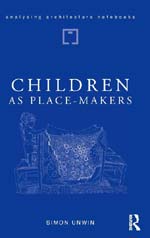
|

|
|
Home Site Search Contact Us Subscribe
|
|
Who Isn't a Born Architect? Simon Unwin envisions children in their playful place-making defining architecture's essence in "Children as Place-makers." By Norman Weinstein September 25, 2019 Truth be told, I was reluctant to title this book review as I finally did. The notion of some universal architect active in every new born babe sounds so irrational and sentimental that I feared losing your attention from the get-go. But why I’m titling this review of Simon Unwin’s Children as Place-makers (Routledge, 2019) with an apparently absurd assertion has to do with an experience I had a few hours ago walking through a hospital corridor on my way to a medical test. You know, when you walk down hospital corridors just about anywhere on earth, you have these room signs with expected titles like “cardiovascular surgery” or “ultrasound lab” or “physicians lounge.” So my expectations of room labeling were jarred when I encountered a door sign reading “City Visibility Room.” Luckily, the door was ajar enough that I could peek in and see a stark room, defined by a plain wooden conference table and chairs – and one huge picture window positioned so that a panoramic view of my city’s foothills filled its frame.
The “Visibility Room” was actually a complete yawn, a “nothing space” – save for its window. Which actually made it the most remarkably engaging architecture I’ve ever seen in a health facility. It was as if that room offered a primal healing space, one that was without all the design elements one would expect in a modern urban hospital. Not a hint of technological sleekness was apparent. No pleasingly tepid colors on floor or walls. It marked a healing place, inadvertently, far more than the lab that was my final destination on that hospital floor, or the garish casino-like hospital lobby. I think any child – or adult for that matter – could have designed that “visibility room.”
And my experience of that space was immeasurably enriched by Unwin’s book. Like Unwin’s earlier books, particularly his remarkable Analyzing Architecture Notebooks, he writes with deceptive simplicity. His lifetime writing about architecture seems like a tremendous amplification of the approach taken by Steen Eiler Rasmussen in Experiencing Architecture (The MIT Press, 1959). Rather than reducing architectural understanding into a playing field of language and number games, Unwin, following Rasmussen, wants to awaken your senses and emotions so vividly that you experience your primal will to make places notable. As he eloquently writes:
Place is the seed and core of all architecture. . . .What we as children are doing when we make places is a mode of creative research. This kind of research is not the same as that which we call scientific, which conducts experiments to understand how natural phenomena work. The research in place-making is into our own relationship with and agency in the world: it explores what we can do to alter the world to accommodate ourselves. . .
Through brief one-page meditations, accompanied by Unwin’s winsome drawings, on commonplace childhood activities like sand castle building and play forts built of tree branches, he gradually demonstrates how elemental place-making evolves into adult architectural designs. Given the rigorous professional training architects need to attain in order to practice, Unwin’s focus might seem like a discounting of the technical skills architects as adults need to master. But in no way do I find his approach anti-intellectual or counter-professional. He is insisting on the root-impulse that drives one to become an architect in the first place, a primal impulse that can all too easily become forgotten during the rigors of academic training and daily professional practice. This book is really a primer about architectural imagination that begins intuitively, unselfconsciously in childhood. That was perhaps what Picasso had in mind when he remarked: “It takes a very long time to become young.” Unwin’s extraordinary book may reduce the time needed to design with the freshness reflecting a child’s vision of place.
Norman Weinstein is the author of “Words That Build” – an exclusive 21-part ArchNewsNow.com series about writing as a keystone of a successful architectural practice. He's authored several books of poetry and books about music and literature. Weinstein is currently learning weaving in order to deepen his understanding of architecture, music, and poetry. He can be reached at nweinstein25@gmail.com.
More by Weinstein:
Weinstein: From Ada to Zaha and Everything In Between Op-eds, book reviews, musings, and debate.
An exclusive 21-part series that focuses on the overlooked foundations of architecture: oral and written communication.
Most recent:
Book Review on the
Day of a Book Launch Party for nARCHITECTS
Best
Bauhaus Books to Peruse During the Bauhaus Centenary
Best
Architecture and Design Books of 2018
Writing About Architecture As If Only Art Matters A new coffee table book about Frederic Church's Olana combines resplendent photography with essays reflecting architectural myopia.
Welcome New Books Reveal the Heart of the Matter in Architectural Design Kenneth Frampton's new edition of Kengo Kuma's works, along with Kate Franklin and Caroline Till's global survey of novel thinking about sustainable materials, offer new slants on how materials matter.
Educating Future Architects to Think Like Curious Clients Expanding architectural education to include more about client consciousness is a key to enriching the profession.
Architectural Education at the Crossroads? Educators Duo Dickinson and Phil Bernstein look in opposite directions when assessing architecture school quality - but the next architecture school transformation may emerge from where no one is looking.
|
(click on pictures to enlarge)  Routledge Children as Place-Makers by Simon Unwin |
© 2019 ArchNewsNow.com